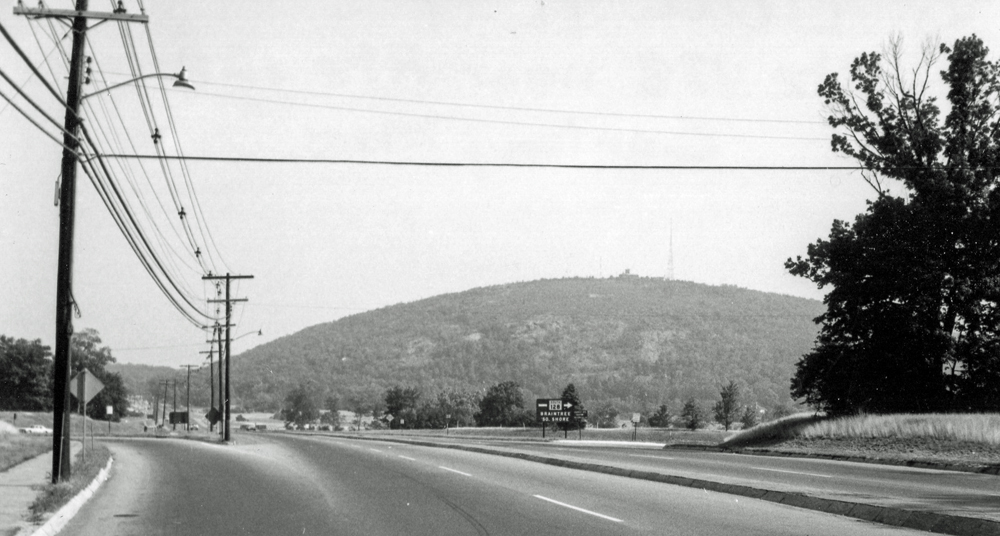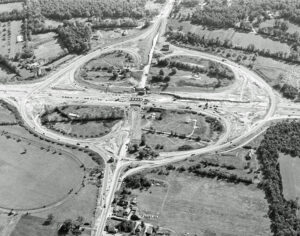True Tales from Canton’s Past: Dad planted that tree
By George T. Comeau
The trees began to take root in this 1965 photo taken by Ed Galvin. (Courtesy of the Canton Historical Society)
Jim Roache is a good father, but like all dads he has an arsenal of stories and “dad” jokes. Often times when he is with his daughter Kaitlin, they will drive up the hill in Ponkapoag and when approaching the Route 128 cloverleaf, Jim will turn to his daughter and point toward the highway interchange and exclaim, “I planted that tree.” With a roll of her eyes, Kaitlin smiles and thinks that her dad must be losing it.
It turns out that Jim likely did plant that tree. And there are lots of folks in town who may be able to make the same boast. The story of the trees at the cloverleaf in Ponkapoag is a story rooted (pun intended) in the nascent ecology movement and triggered by John F. Kennedy. It began in 1964, less than six months after Kennedy was assassinated. While the nation was left reeling from the events of that day, Canton in particular was deeply affected. Prior to the assassination, Kennedy had been working to have part of the National Aeronautics and Space Administration (NASA) based in Massachusetts, and Canton selectmen had worked on a pitch.
In the summer of 1964, the city of Cambridge lobbied NASA to build its Electronics Research Center in Kendall Square, and NASA ultimately chose the site out of 160 possible locations. Earlier that year, in April, the Canton Industrial and Development Committee met with NASA officials to persuade them that choosing Canton at the Neponset Meadow site would support the proposed research center. The presentation climaxed months of preparation as committee members outlined the “numerous advantages” that the Canton area had to offer, including direct highway access via the recently completed inner beltway known as Route 128. In the end, however, Canton did not prevail.
Cambridge, meanwhile, tentatively succeeded as the Cambridge Redevelopment Authority agreed to sell 14 acres of the run-down neighborhood to the federal government. Work started on six new buildings, which were to house developments on systems for communications, information display and automated spacecraft landings. The project fizzled, however, and by 1969 NASA pulled the plug and left Cambridge altogether.
This is all to say that the people of Canton were well aware that they could be players on a national stage. The new highway system that welcomed people to the town at the foot of the Great Blue Hill had just been completed. But the project also left its scars on the landscape, as several historic farms had to be cleared to make way for the interstate highway. There was no money for beautification and the earth was torn up to such an extent that it was a genuine eyesore to the gateway of the town. So in the name of Kennedy, the town took action.
Under the concerns that the president had voiced prior to his death — that his own native area would become a “gigantic metropolitan area without sufficient green” — a rallying cry went out, and a new program, called Canton Plantations, was born. The project had the aims of beautifying Canton, raising a living memorial to President Kennedy, allowing people to take part in a meaningful community project and increasing the value of homes. The committee was formed by Brooks Beck, MacLaren MacGregor, Henry Lyman, Edward Galvin and Maurice Ronayne, who all contributed heavily to the sense of civic pride in the community.
The mission of Canton Plantations was to plant 20,000 trees over the course of five years with the hope that “other communities in the commonwealth and nation may undertake similar programs.” Governor Endicott Peabody was enlisted in support and plans took shape for a kickoff event during the first weekend of May. Joining the effort were several local Boy Scout troops, Camp Fire girls and Girl Scouts, as well as the Canton Community Club, Rotary, Knights of Columbus, Garden Club, CYO, and the entire school system. It was an enormous undertaking, and as foundational groups joined even more stepped forward.
What must have been one of the most ambitious community events of its day also saw several local businesses step up. Five-year-old spruce trees were sold at Canton Lumber & Supplies, Fallon’s Service Station, Canton Public Market, the Little White Store, Crowell’s Store and Blue View Nursery. Pop-up sales happened in parking lots across the town, and literally thousands of trees were sold for $1, with 90 cents being donated to the nascent Kennedy Memorial Library and 10 cents towards the purchase of even more trees. Overall, the event raised more than $2,300 for the Kennedy Library.

An aerial view of the Route 128 cloverleaf — looking south towards Canton — under construction at the interchange in Canton. (Northeastern University Library, Archives and Special Collections)
On the morning of Saturday, May 2, more than 200 youths gathered alongside 50 or more adults at the Indian Line Farm just south of the new cloverleaf. Governor Peabody was there and “rolled up his sleeves and manned a shovel,” remarking that his hope was the example in Canton would “catch the imagination and engage the support of other communities in the state.”
“There is a seed of good in this and we hope it may spread through the American land,” the governor was heard saying. Peabody himself planted a flowering dogwood that day as a special gift from Blue View Nurseries, which at the time was located at the end of Royall Street.
The Boy Scouts and youth of Canton were pivotal in this project. The day was described as a “fine demonstration of what the Boy Scout movement can do to instill a sense of duty and morale in a group of younger boys.
One of those scouts was Fred Noll. “It was an event that I still recall to this day,” said Noll, who is now in his 70s. “My dad, Gus, was a custodian at Canton High School, and he loved planting trees.”
“We dug a few holes, and worked that entire day,” Noll continued. “My dad was always upset when the power company trimmed the trees on Messinger Street, where we lived a the time.”
Noll was an Eagle Scout and in 1969 went on to attend West Point. On that day so many years ago, he planted a double flowering crabtree. Trees were important to Noll — and apparently to the thousands of other Cantonians who flocked to the Canton Plantations project.
On the evening before the planting, John Farrington and Butch King, alongside a handful of volunteers, separated and packaged each small tree in preparation for the next day. As the sun rose on Ponkapoag, all was ready and hundreds arrived. As the small army of men, women, boys and girls marched down Route 138, they were assigned to each of the four quadrants of the cloverleaf. The men from A.A. Will had furrowed the land to make way for the trees, and the Fire Department sent their water truck, headed by Bobby Beasley, to begin the watering process. Truckloads of mulch came in from Maltby & Co. in Stoughton, and work progressed quickly.
Jim Roache was indeed there that day and worked alongside Beasley and the water brigade as they distributed 1,600 gallons of water. Members of Boy Scout Troop 172 made up a large contingency of the workforce that day. High school kids were another large component as Canton Plantations, unlike any other event, ignited the imagination of all the generations in town to work together for a common cause.
Two thousand trees were planted as a result of that project, and many of them remain to this day. What had been a naked and ravaged landscape was transformed and today stands in testament to what a community can accomplish. Yes, Kaitlin, Dad did plant that tree!
Short URL: https://www.thecantoncitizen.com/?p=89499










